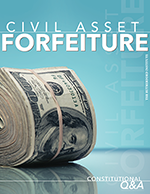On The Front Lines
Rutherford Institute Denounces Justice Dept. Plan to Expand Policing for Profit Schemes, Issues Constitutional Guidance on Civil Asset Forfeiture
Charlottesville, Va. — The Rutherford Institute has issued constitutional guidelines on the government’s excessive and controversial use of civil asset forfeiture, also referred to as “policing for profit,” which allows police to arbitrarily seize private property—cars, cash, jewelry, homes, etc.—without having to charge the owners with a crime. Once the assets have been seized, police divvy up the profits with the federal government, establishing what Rutherford Institute attorneys refer to as an “incentive-driven excuse for stealing from the citizenry.” The publication of the Institute’s guidelines coincides with a recent announcement by Attorney General Jeff Sessions that the Justice Department plans to expand law enforcement’s use of civil asset forfeiture even in states that have restricted the practice.
The Rutherford Institute’s “Constitutional Q&A: Civil Asset Forfeiture” analyzes the government's use of civil asset forfeiture to seize private property and valuables, exposes the harmful impact such overreaching policing methods can have on innocent Americans, and provides a legal framework for understanding how civil asset forfeiture flies in the face of longstanding constitutional safeguards against such abusive tactics by government agencies.
“If the government can arbitrarily freeze, seize or lay claim to your property (money, land, or possessions) under government asset forfeiture schemes, you have no true rights,” said constitutional attorney John W. Whitehead, president of The Rutherford Institute and author of Battlefield America: The War on the American People. “What little hope remains for ending the government’s abusive civil asset forfeiture schemes rests largely with the citizenry and their willingness to become engaged, informed and actively involved—especially at the local level—in grassroots efforts to demand transparency, accountability and reform.”
Americans are supposed to be presumed innocent until proven guilty. Civil asset forfeiture, however, turns that rule on its head. In fact, with civil forfeiture, the property is guilty until the owner proves its innocence. Here’s how the whole ugly business works in a nutshell: First, government agents (usually the police) use a broad array of tactics to profile, identify, target and arrange to encounter (in a traffic stop, on a train, in an airport, in public, or on private property) those individuals who might be traveling with a significant amount of cash or possess property of value. Second, these government agents—empowered by the courts and the legislatures—seize private property (cash, jewelry, cars, homes and other valuables) they “suspect” may be connected to criminal activity. Then, whether or not any crime is actually proven to have taken place, without any charges being levied against the property owner, or any real due process afforded the unlucky victim, the property is seized by the government, which often divvies it up with the local police who helped with the initial seizure.
The burden of proof ultimately falls on the unfortunate citizen, who must mount a long, complicated, expensive legal campaign to prove their innocence in order to persuade the government that it should return the funds they stole. Not surprisingly, very few funds ever get returned. For instance, Kentucky resident Gerardo Serrano had his new Ford pickup truck seized by customs agents after a search of his vehicle uncovered five bullets in his truck’s console. The bullets belonged to the man’s lawfully owned gun, which he had left at home. Although Serrano was never charged with any crime, the government has refused to return his truck.




